Chapters
- Perimeter
- Area
- Perimeter of a Triangle
- Area of a Triangle
- Example
- Area and Perimeter of a Square
- Example
- Area and Perimeter of a Rectangle
- Example
- Rhombus
- Example
- Area and Perimeter of a Rhomboid
- Example
- Area and Perimeter of a Trapezoid
- Example
- Area and Perimeter of a Regular Polygon
- Examples
- Area of a Polygon
There are different types of polygons that there is no single formula to find area and perimeter. In fact, for every type of polygon, there is a different formula. That is why, in this resource, we will cover areas and perimeters of commonly used polygons.

Perimeter
Often students ask what is the perimeter? It is the calculation of the length of the boundary of any shape. The best way to learn how to find the perimeter easily is by adding all the outer sides of a shape. A polygon is no exception. In short, the perimeter of a polygon is equal to the sum of the length of its sides.
Area
Finding the perimeter is easier but finding the area is a bit complex. The area is a region which a shape occupies. There is no easy way of finding the area, you will need to memorize some formulas for finding the area. But the question is, what is an area of a polygon? The area of a polygon is the measure of the region enclosed by the sides of a polygon.
Perimeter of a Triangle
Let's begin with something that you will a lot in your life and yes, that is the triangle. Calculation of the perimeter of a triangle is very easy. All you need to do is to add all the side lengths. There are three sides in a triangle and that means you need to add all three sides to find the perimeter. This is the basic concept of the perimeter of a triangle but a triangle also has three types. Does this mean every triangle will have a different way to find its perimeters? Absolutely not! The concept will remain the same which is the addition of the three sides. Let's take a look at it.
| Equilateral Triangle | Isosceles Triangle | Scalene Triangle |
 |  |  |
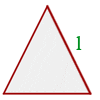 |  | 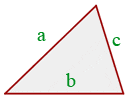 |
Above is a comparison of all three triangles with their perimeter formulas. A scalene triangle has all different sides, therefore, the formula remains the same, however, with equilateral and isosceles triangles, there is something different? Nothing is different, the concept is the same but with a twist. In an isosceles triangle, you know two sides are equal, let's say one side is equal to "l". That means we will have  since the base of an isosceles triangle is always different. The overall equation will be
since the base of an isosceles triangle is always different. The overall equation will be  because both lengths are added. The same case is with an equilateral triangle, all three sides are equal and if one side is equal to "l" then their sum will be equal to
because both lengths are added. The same case is with an equilateral triangle, all three sides are equal and if one side is equal to "l" then their sum will be equal to  .
.
Area of a Triangle

Whether you are working with an isosceles triangle or a scalene triangle, you will require only one formula that can calculate the area of a triangle. In short, this formula can be used to find the area of any triangle that you are working with. This formula is only valid for triangles only, you can't use this on other polygons. If a polygon has three sides then the area of that polygon will be:

The area of a triangle will be half product of base and height.
Example
Find the area and perimeter of the following triangle:





Area and Perimeter of a Square

One of the easiest polygons is the square. All the sides are equal and this polygon has four sides. The vertices have an angle of  . You might have guessed the perimeter by now, yes it is equal to
. You might have guessed the perimeter by now, yes it is equal to  because all the sides are equal and since a square has four sides, therefore it will be
because all the sides are equal and since a square has four sides, therefore it will be  . To find the area of a polygon with 4 sides, you need to multiply the length of that polygon by the breadth(width) of the polygon. Since all sides are equal, the length ("l") with be multiplied by the width ("l"), hence:
. To find the area of a polygon with 4 sides, you need to multiply the length of that polygon by the breadth(width) of the polygon. Since all sides are equal, the length ("l") with be multiplied by the width ("l"), hence:

All you need is the length of any side of a square to find the area and the perimeter of the square.
Example
Calculate the area and perimeter of a square with  sides.
sides.





Area and Perimeter of a Rectangle
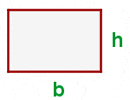
Not every time the length and the width of a four-sided polygon will be the same. If the length and width of a four-sided polygon are different that means you are dealing with a rectangle. However, the concept of perimeter and area will be the same for a four-sided polygon.


Example
Calculate the area and perimeter of a rectangular with a base of  and a height of
and a height of  .
.





Rhombus
Rhombus is another four-sided polygon but with different properties. The concept of perimeter and area will be the same for the rhombus. To find the perimeter, we need to add all the four side lengths of the rhombus. Since all the sides of a rhombus are equal, they will all add up and the easiest way to find the perimeter of a rhombus is to multiply the length of one of its sides by four. However, finding the area might be a little tricky. In a rhombus, there are two diagonals, one is the big diagonal while the other is a short diagonal. The area of a rhombus will be the half product of both diagonals.



Example
Calculate the area and perimeter of a rhombus whose diagonals are  and
and  , and its side measures
, and its side measures  .
.





Area and Perimeter of a Rhomboid
Rhomboid might look like a rhombus but it isn't. You might not be familiar with the name rhomboid, it is also known as a parallelogram. In rhomboid, two opposite sides are parallel to each other. The perimeter will be the addition of all four sides. Since the opposite sides are equal in a rhomboid, you can add the length and width and then multiply it by two. The area of the rhomboid is the product of the width and the height of the rhomboid.
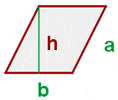


Example
Calculate the area and perimeter of a rhomboid shape of 4 sides of 4.5 cm and a height of 4 cm.
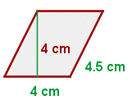




Area and Perimeter of a Trapezoid
Trapezoid (also known as "Trapezium") is another type of polygon that contains five sides. The unique part of this polygon is that it has two parallel sides. That makes the trapezoid unique from all other five-sided polygons. The area of the trapezoid is the half product of the height and the sum of the parallel sides. The perimeter of this shape is very simple, just add all the boundary lengths of trapezoid.
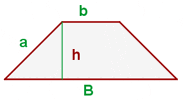


Example
Calculate the area and perimeter of the following trapezoid:







Area and Perimeter of a Regular Polygon
A regular polygon means that all its sides are equal in length. Normally, polygons don't have all sides equal, however, in the case of a regular polygon, it should have all sides equal. Since all sides are equal, that indicates that all angles will be equal too. To find the perimeter of any regular polygon, all you need to do is to multiply the number of sides by the length of one side. However, finding the area of a regular polygon is a bit tricky. The area would be half of the product of perimeter and apothem. Apothem is the distance between the centre of the polygon to the mid-point of any side of a regular polygon.
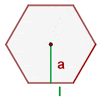

where n is the number of sides.

Examples
Calculate the area and perimeter of a regular pentagon with sides of  .
.

By applying the Pythagorean theorem for one of the triangles, we obtain:







Calculate the area and perimeter of a regular hexagon inscribed in a circle of  radius.
radius.
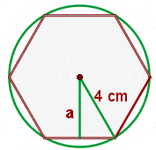






Area of a Polygon

A polygon doesn't have a specific shape. If a shape fulfils all the conditions then we will call it a polygon. Consider the above geometry. It looks different but, we can break it into four different triangles and since a triangle is a polygon, therefore, the above shape is also a polygon. To find the area of the above geometry, you need to break the figure and then calculate the area of the broken parts. The area is obtained by triangulating the polygon and adding the area of these triangles.

Calculate the area of the following polygon:

The above geometry can be broken into two shapes, one is the triangle and the other is the rhomboid. To find the perimeter, just add all the boundary lengths.



















I’m just curious if the area between the polygon and the circumscribed circle has a name.
https://www.superprof.co.uk/resources/academic/maths/geometry/plane/orthocenter-centroid-circumcenter-and-incenter-of-a-triangle.html